IRAN-US CONFLICT
Tehran and Washington grapple with unintended consequences
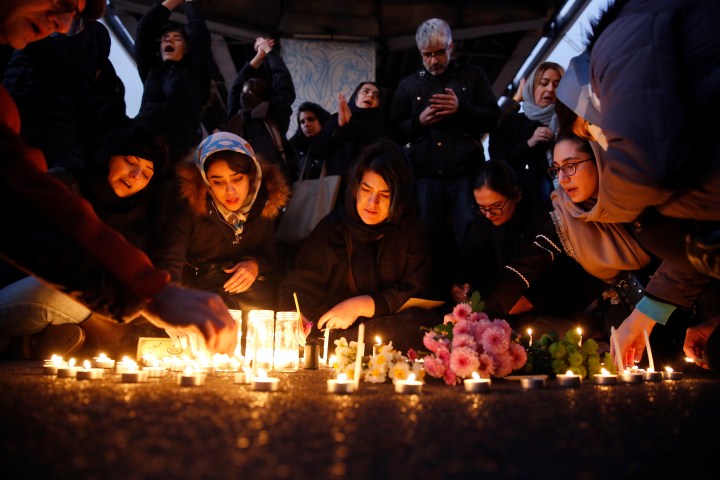
The Iran-US confrontation grinds on, even as large crowds in Tehran now seem to have switched sides following the fatal shooting down of a Ukrainian Air passenger jet by Iranian forces and the clumsy response by Iran’s government to that tragedy.
I can show you the world
Shining, shimmering, splendid
Tell me, princess, now when did
You last let your heart decide?
I can open your eyes
Take you wonder by wonder
Over, sideways and under
On a magic carpet ride
A whole new world
A new fantastic point of view
No one to tell us no
Or where to go…
From the film Aladdin. Song, A Whole New World
— lyrics by Tim Rice, music by Alan Menken.
If only the actual rulers of the two not-so-mythical kingdoms of America and Iran had listened to the subliminal meanings of this little song, instead of the whisperings from all those jittery, evil jinns perched on their respective shoulders, this might actually be a whole new world — and a better place for you and me too.
But the song is just a Disneyfied version of an age-old Middle Eastern tale. Instead, around these parts, this is the real world. Here, generals plot mysterious deeds against their enemies. Politicians plan to do away with rival generals. Generals can get blown up by a drone missile, more missiles can hit air bases all across modern-day Iraq. Still, other missiles can blow a passenger aircraft out of the sky in a terrific, horrible, and very deadly “oops” moment. And all of this has seemed, at least at first, like the prelims before the actual hostilities got going.
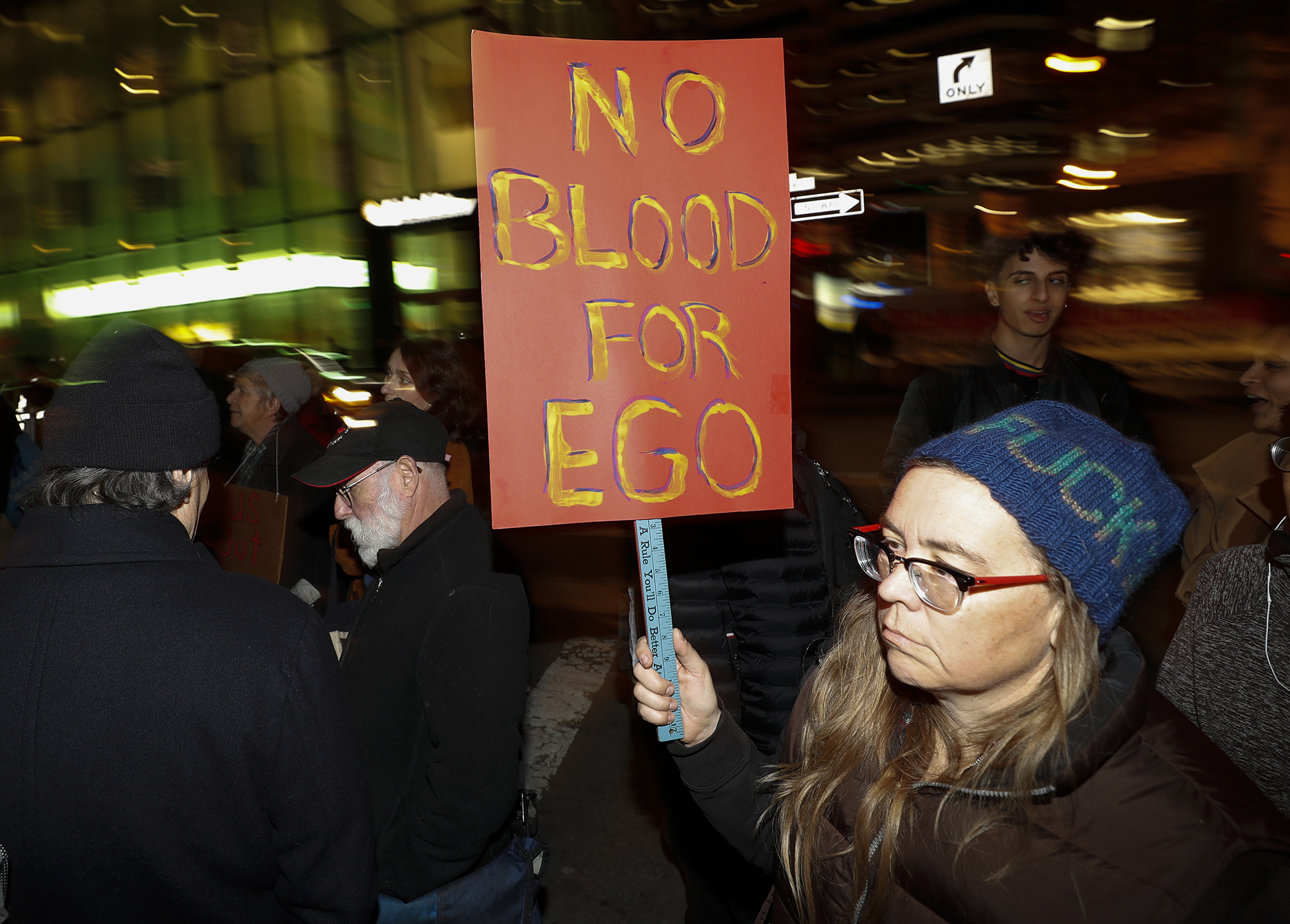
A protester participates in the ‘No War with Iran’ demonstration in San Francisco, California. Tensions between the US and Iran reached critical levels after US President Donald Trump ordered the assassination of Iranian General Qasem Soleimani. The assassination was carried out by a drone strike near Baghdad International Airport in Iraq on 3 January 2020. (Photo: EPA-EFE / John G.Mabanglo)
Now how in the hell did the hostility get to this point? In two previous columns, Trump still crying havoc and Is it all downhill from here for the US and Iran?, we offered an overview of the history of modern US-Iran relations and explanations of the texture of the ongoing contretemps between the two nations, largely playing out over the Iraqi landscape.
Sadly, that nation has been beset by much trouble over the past quarter-century or so, initially from the delusions of a dictatorial strongman, hereafter from a long war with Iran. That was followed by a senseless invasion led by the US on the grounds of some serious mistruths. Then it was further ground down by a series of civil insurrections, and most recently by a fanatical, devastating “caliphate” declared by IS/Daesh/Islamic State. The latter was largely defeated by an informal coalition of US and Iraqi forces, along with the very militias guided by the general who was killed in that drone strike. But that was then; this is now.
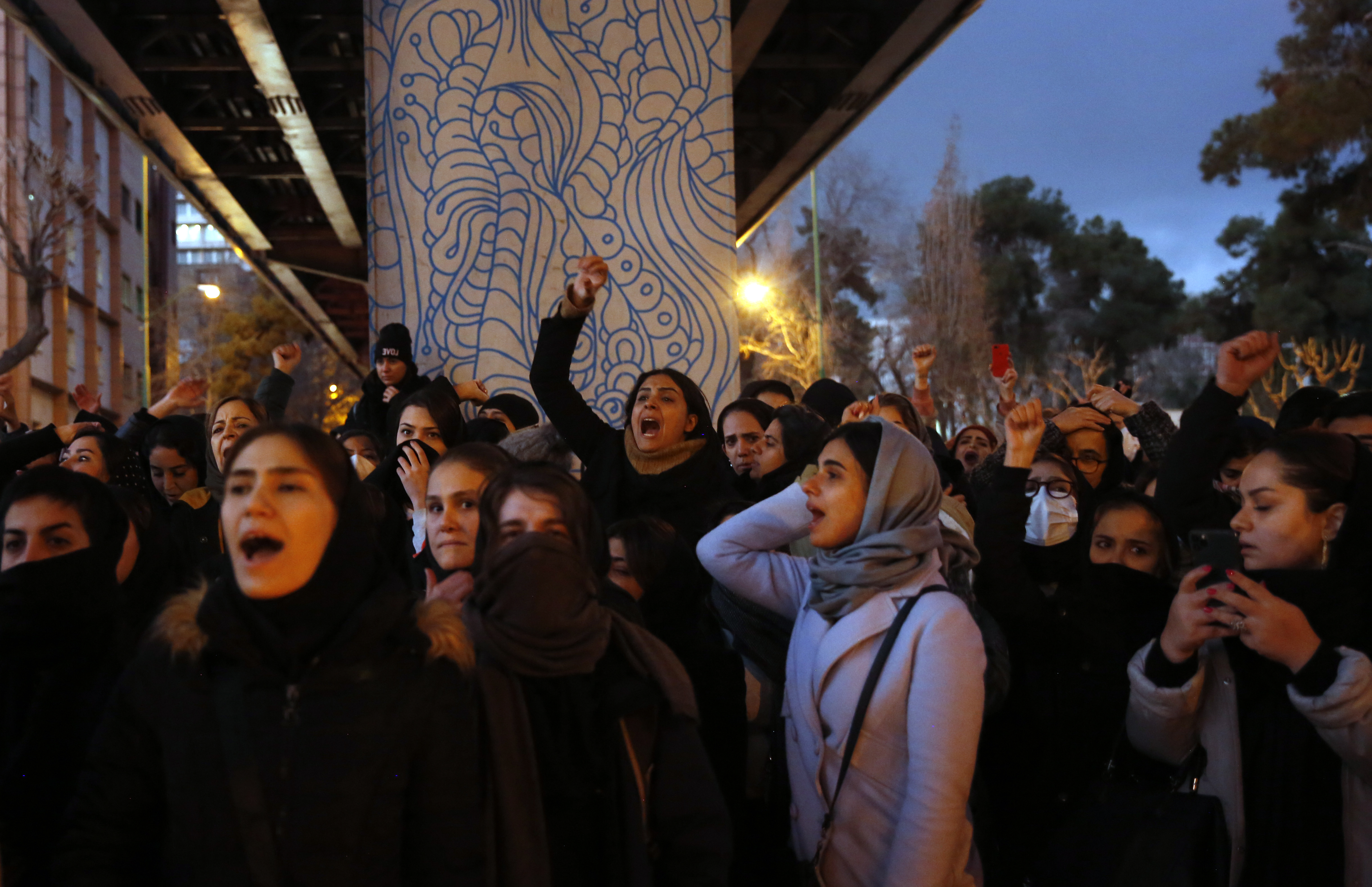
Iranians protest to show their sympathy for victims of Ukraine International Airlines flight PS752 in front of the Amir Kabir University in Tehran, Iran on 11 January 2020. (Photo: EPA-EFE / Abedin Taherenareh)
Some months earlier, it seems, the American president made the decision to authorise killing Iranian General Qasem Soleimani, head of the Quds Force of the Revolutionary Guard, and one of the country’s most powerful (and charismatic) military figures. Thus there are now hints that decision came earlier than was implied in the administration’s public statements, which gives a sense that the pretext of the death of a US citizen contract interpreter may have been more of an after-the-fact justification than a response taken in the white heat of terrible, righteous indignation.
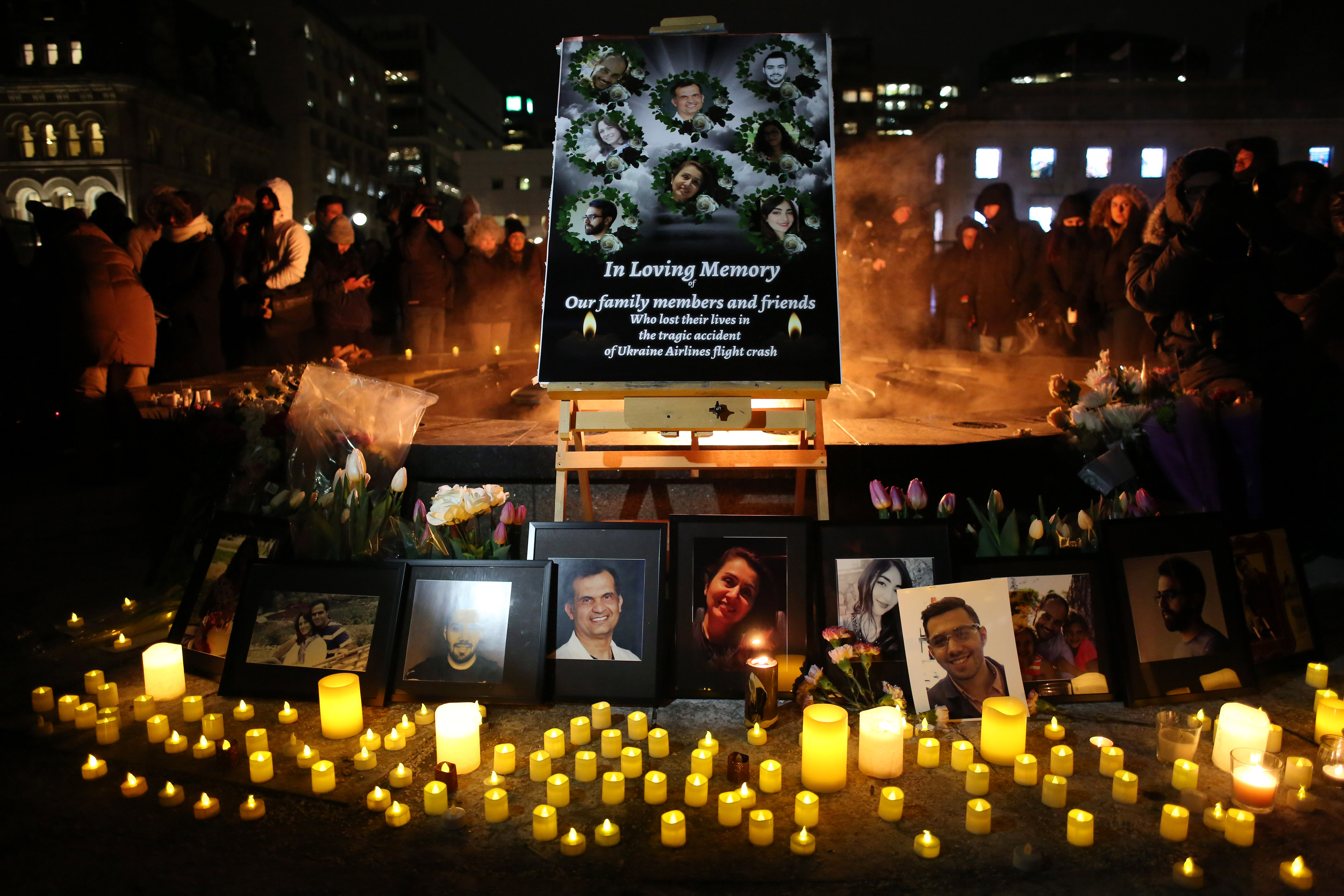
People gather around an altar in Ottawa, Canada with photographs of the Tehran plane victims who died after a plane was shot down by the Iranian military. (Photo: Dave Chan / Getty Images)
According to MSNBC on 13 January, “President Donald Trump authorized the killing of Iranian Gen. Qasem Soleimani seven months ago if Iran’s increased aggression resulted in the death of an American, according to five current and former senior administration officials.The presidential directive in June came with the condition that Trump would have final sign-off on any specific operation to kill Soleimani, officials said.” Uh oh.
The decision was apparently rooted in Trump’s growing animus towards the general (even if in his presidential campaign Trump had been thoroughly confused by the differences between Kurds and Quds), as part of his more general displeasure towards Iran. Thus, was this attack on the general an action in search of a justification? Perhaps Congress needs to ask some serious questions about this.
As things had turned out, the US military had provided Trump with a range of options for disrupting the Quds Force and the general’s other nefarious works, especially when it was discovered the general in question was coming through Baghdad, after consulting with Iranian-guided militias in Syria and Iraq. But, earlier, apparently thoroughly shocking his briefers, Trump’s eyes went unerringly to choice Z — offing the general with a drone strike — rather than picking any one of those sissy choices weak, irresolute souls like Barack Obama or Jimmy Carter would have selected.
This kind of thing is, of course, is what strongmen, the ones busy making America great again, must do — even if they are on the hot griddle over that hoax of an impeachment trial and facing a re-election race in less than a year. The point, apparently, is to never, ever look weak like Carter or Obama, what with the disastrous American hostage crisis in Tehran in 1979-80, or those embarrassing deaths at the temporary US consulate in Benghazi, Libya, back in 2012.
But even as the drone missile did its work, the Trump administration was becoming busy trying to sort out its reasoning, rationale and evidence for this mission. The president had initially said the government had rock-solid evidence of an imminent plot to attack Americans and their facilities in the region, although he offered little clarifying information.
Along the way, Trump also tried out the idea of destroying 52 Iranian cultural sites, at which point the Iranians threatened destruction of six times as many American targets. Never mind that various American officials were trying to chivvy the president away from even mentioning cultural sites, given that such attacks would violate international treaties for which the US is a signatory nation.
Then the president said the evidence pointed to imminent attacks on not one, but four US embassies. Just take his word for it. (In my own mind, I recalled how Adlai Stevenson, as America’s UN ambassador, had shown the world photo after photo, clearly demonstrating Russian missile installations in Cuba in October 1962, and challenging the Soviet ambassador to even try to deny the truth of this to the UN.)
As the days following the missile strike moved along, the Trump administration kept trying its hand at offering a convincing argument for the drone attack. For the logic of it, they relied upon the doctrines of an obligation to protect, the responsibility to defend national security and personnel, and the urgency of preventing such imminent attacks from occurring, in order to explain the logic of this particular missile strike at this particular time.
But actual convincing evidence was never offered to the American nation as a whole, to the US Congress, or the world at large. Instead, among the president, secretary of state, secretary of defence, and the national security adviser, a growing fog of confusion gradually took over. In the crosshairs, as a target, it was either the embassy in Baghdad, or it was four embassies in the region, or it was no specifically named place, facility or people; and the attacks were right around the corner, or there was no precise timeline, and the imminence of this increasingly vague threat was increasingly unclear.
As the Washington Post 202 Newsletter put it on Monday, 13 January:
“The Sunday shows starkly displayed the consequences of the president’s decision to squander his credibility by playing so fast and loose with the truth throughout his tenure. Trump’s own top aides declined to confirm his declaration on Friday that intelligence showed the Iranians were looking to ‘blow up’ four US embassies.
“ ‘I didn’t see one with regard to four embassies,’ Defense Secretary Mark Esper said on CBS, referring to intelligence reports. ‘What I’m saying is I share the president’s view that probably — my expectation was – they were going to go after our embassies.’
“National security adviser Robert O’Brien said on Fox that it’s difficult ‘to know exactly what the targets are,’ but it’s not unreasonable to anticipate a future Iranian attack ‘would have hit embassies in at least four countries.’
“On CNN, Esper said ‘there was intelligence that… there was an intent to target the US Embassy in Baghdad.’ He said the details been shared with the Gang of Eight. House Intelligence Committee Chairman Adam Schiff (D-Calif.), a member of the group, said that’s not true.
“O’Brien acknowledged on NBC that the US Embassy in Baghdad was not informed of an imminent threat against it, something that would be standard operating procedure. ‘As soon as it looked like there was going to be some sort of action against a US Embassy,’ he said, ‘the president was decisive and bold in his action.’ ”
Message discipline is clearly not right up there at the top line of things in the Trumpian playbook. Any real clarity over this strike seems less and less likely to come forth, the longer things go on.
Meanwhile, the death of the general set off a whole additional chain of events. The Iranian government promised vengeance and appropriate retaliation, and launched a dozen precisely targeted missiles at two Iraqi air bases that also house American and other coalition forces. Given that either the Iranians gave a thorough heads up on the launches or the Americans picked up precise signal intelligence on the launches, or perhaps both, no casualties were sustained.
Honour assuaged, the Iranians let it be known to their population and the world that things were now even, especially since the Iranian government announced there were dozens and dozens of casualties from their strikes. In reply, the US president authorised new sanctions on Iran and various of its leaders, despite some experts saying that beyond these sanctions on things such as iron and steel exports and personal limitations, there was now little left to punish. In the middle of this, a significant chunk of Iraqi parliamentarians voted to ask the country’s prime minister to tell Americans to take their forces out of the country. (In response, Trump threatened economic sanctions against Iraq.)
Meanwhile, Habib Ahmadzadeh, the Iranian minister for foreign affairs, had replied with his own rather snarky note (matching Trump’s tone when he announced new sanctions), that said in part:
“War is not our business, but negotiations and diplomacy are. War is not our purpose. Peace is our mission. Peace is our philosophy in life, and you are right, diplomacy is our art.
“Iran has proven its mastery in the art of diplomacy. Diplomacy, forbearance and patience are inclinations that cannot be achieved by billions of dollars of weapons.
“The United States’ allies in the region, including Saudi’s Bin-Salman and Israel’s Bibi Netanyahu, can testify to that. They have spent many billions of dollars in arms sales, but have not been able to dominate Iran. Just be aware, Mr President, that your friends on the #Bteam are pushing you into the same quagmire they created with Iraq.
“In desperation, they have now tied the hands of our master of diplomacy, Foreign Minister Javad Zarif, by imposing sanctions on him. They should have learned their lesson by now — they might be able to tie the hands of our master chess players, but we will find other ways to move the pawns and horses. And a final word of advice: Don’t play checkers with the grandmasters of chess.”
By that point, Soleimani’s remains had been brought back to Iran to a human tidal wave of mourning — and dozens actually died in the crushes that were part of that outpouring of public grief. And then a new disaster occurred.
A Ukrainian Air passenger jet was struck by an Iranian ground-to-air, Russian-supplied missile, less than eight minutes after its take-off from Tehran’s airport. The plane crashed, killing all 170 passengers and crew on board.
The Iranian military and government’s first instinct was to blame everyone and everything else, from pilot error to equipment failure to hostile foreign intervention by one of the usual suspects on Iran’s enemies list. The immediate problem was that the passenger list included many Iranian students heading to Canada, as well as Canadians of Iranian descent.
It took several days for the Iranian military to fess up to its error, arguing rather lamely they thought it was an incoming foreign missile headed for Tehran. This was in spite of the fact the plane’s IFF (friend or foe) transponder was reportedly tuned to the correct frequency and the inconvenient fact a passenger airliner definitely has a significantly different radar silhouette from an incoming missile. Oops.
Yes, fatal mistakes happen at a time of real or impending hostilities. There is, after all, the example of that earlier downing of an Iranian Air passenger plane by a US Navy ship, stationed in the Persian Gulf in 1988, at the height of the Iran-Iraq War. (This incident has significantly faded from memory in the US, but remains well-remembered in Iran.)
Following that incident, the Reagan administration issued a formal diplomatic note, expressing deep regret, although the United States did continue to insist that the ship, the USS Vincennes, and its captain and crew had acted in self-defence while patrolling in international waters.
Some eight years later, the two nations reached a settlement via the International Court of Justice which read in part, “…the United States recognised the aerial incident of 3 July 1988 as a terrible human tragedy and expressed deep regret over the loss of lives caused by the incident…” As part of that settlement, the US paid $61.8-million in compensation to the families of the victims.
Meanwhile, back in the present, Iranian crowds were again gathering in the capital’s streets. This time, however, instead of protests over American perfidy, as with some big protests months earlier, these newest protests were against the country’s government over its casualness in killing dozens of its citizens while they were flying over their country in a foreign airliner — as well as the worsening economic and financial circumstances of the country.
Resolving this somehow becomes a real test for the Iranian government and its theocratic overlords — and just maybe an existential one for Iran’s leadership. The Donald Trump administration’s existential tests are coming up a bit later. DM










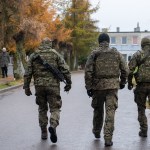









 Become an Insider
Become an Insider